Problem Statement
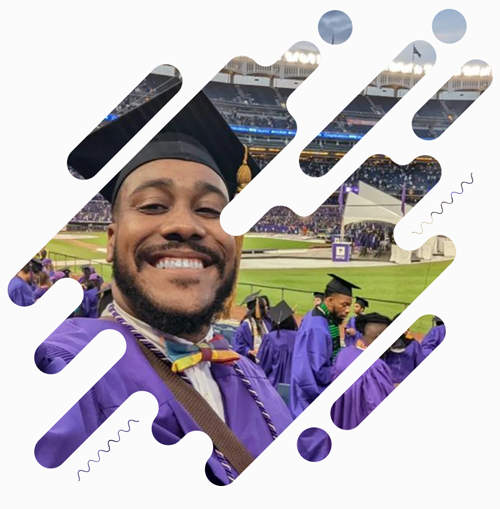
NYU Steinhardt School of Culture, Education and Human Development (Steinhardt) has redesigned their MA in Learning Technology and Experience Design by introducing three areas of specialization and concentration. The program is designed in a way that is responsive to students' goals. As such, students can select their path by either selecting elective courses that will meet their educational needs, or create their own unique a area of specialization with the support and guidance of their academic advisor. With that responsiveness and flexibility in mind, two Digital Media Design for Learning (DMDL) students created a database of available elective courses to support students in finding relevant courses.
With the existing wealth of available elective courses, how might we make students better aware of their choices, and how can we leverage the availability of the course database to support students' decisions on their path of study?
How might we help students learn more about the specializations (from the start of their program and throughout their course of study) - their value and purpose, associated electives, and the curricular and extra-curricular learning opportunities associated with them?
How might we help students identify their professional goals and which specialization(s) best align with their skills and interests?
Context
Overview
The Educational Communication and Technology (ECT) programs at Steinhardt now offer three areas of specialization and concentration. These three areas do not replace the existing areas, but rather complement the existing Games for Learning (G4L) concentration. An overview of those areas is available for prospective students. Current students can access more detailed information on each program. Currently, the ECT program has the following areas of specialization:
- 1. Learning Analytics and Data Science
- 2. User Experience Design
- 3. Transformative Learning Design
Those areas of expertise emerged as the result of the job market, Steinhardt's faculty expertise, and the courses that are (or could be) offered that would enable a deeper focus.
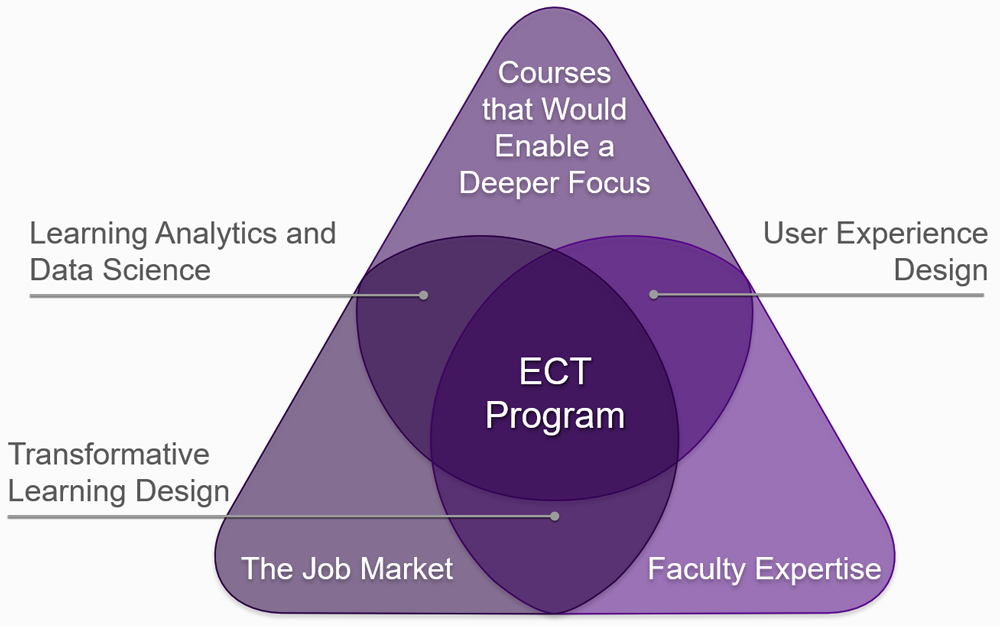
The course database, created as a collaborative app using Airtable, was created with the goal of centralizing the courses that are available each semester for all DMDL and G4L students. The centralization of the courses that pertain to Steinhardt that the app provides gives students easy access of course information. That information can easily be used to decide which courses are available, which have a waitlist, which pertain to other areas of concentration or specialization. The app adds the convenience of complementing the process of course search in Albert, the NYU registration system, searches that have to be performed during every enrollment period, and where all courses are merged with all the courses in the entire institution.
Specializations and Concentrations
For the purposes of this study, the word specialization and the concept of “areas of focus” are used interchangeably. Students can select an area of focus on their studies on their own or with the support of their academic advisors. Also with the help of the academic advisor, they can create unique and specific areas of focus that align to their specific interests. The idea of this flexibility is to provide support for students who wish to go deeper into areas of their professional interest.
The word concentration is similar in concept. However, when we use that word, we refer to a subject or study within a selected major (in this case, G4L). The selected concentration appears on a student’s transcript. It is also officially “approved” by the state at the same time the major was approved.
From an institution perspective, specializations are more flexible and designed to support advisors and students in identifying a focus within the larger degree. In such, they are also easier to modify and adapt to changing times.
Physical (or Cyber) Context
Where do the problem and solution reside?
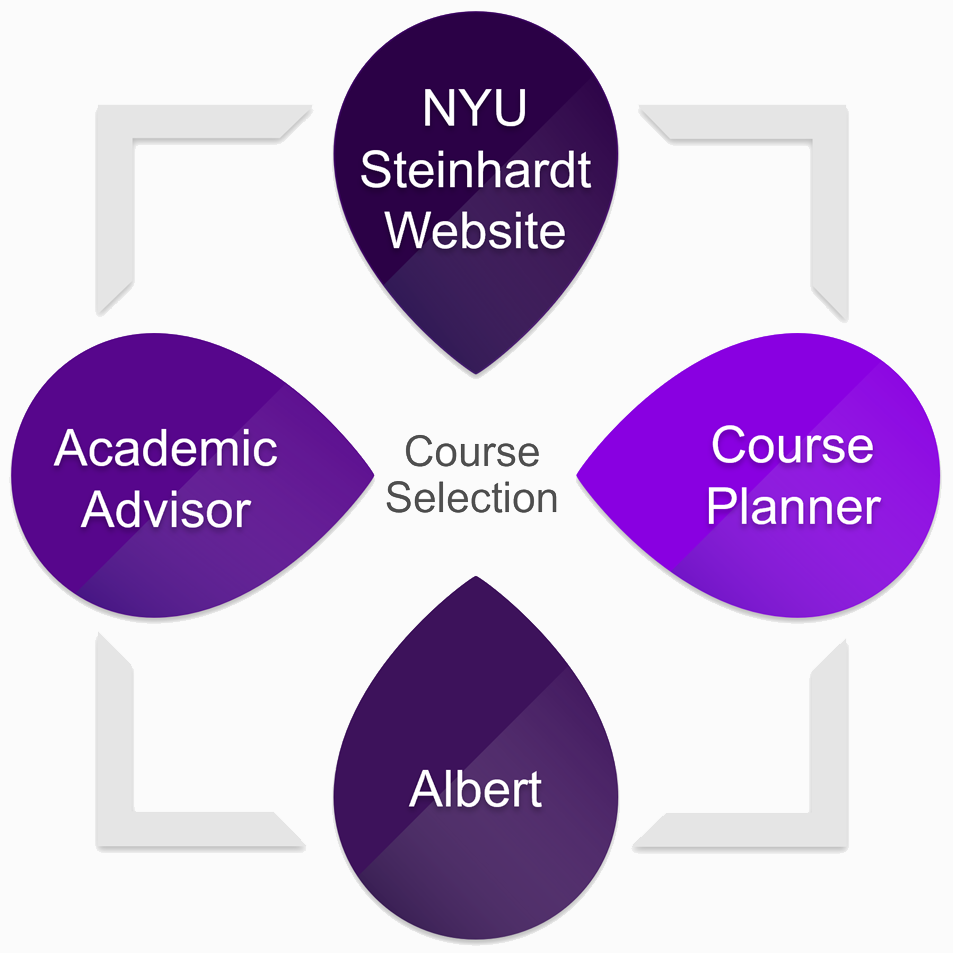
At the present, there are several sources of information that students use at different times during their entire student experience. They are the NYU Steinhardt website, the ECT Student Website (All Things ECT!), the course planner and students’ assigned academic advisor.
A study performed by three DMDL students reveal the intended use for some of those resources is not very clear, nor do they work for the intended purpose.
When is the solution needed (or needed most)?
The solution is needed on an ongoing bases. As programs evolve, updates are necessary to reflect their evolution. Awareness of and access to updated information, resources and communication around the different areas of specialization are necessary at all times througout the lifespan of the students tenure in ECT.
The needs for access to reasources are ongoing, as students might want to communicate questions and search for information to make informed decisions as they progress towards their degrees. The access to reliable and current information is necessary for students to make decisions about registration for courses, discussions with their academic advisors, projects to work during a term, and tracking completion of courses. That means that for this project, there is not really any time throughout the students' trajectory when they “need the solution the most”; students require immediate, current and easily accessible information for different reasons, to be used for different purposes, and at different times before a term starts, during a term, and after a term ends.
Stakeholder Analysis
Improvement of the Educational Communication and Technology Program

Target Audience
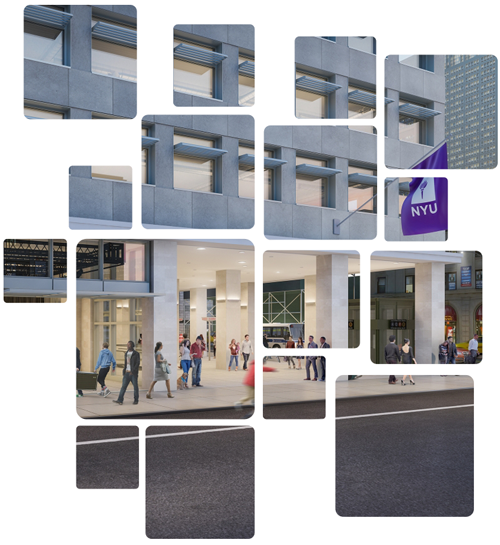
Demographics: NYU Steinhardt graduate and PhD students, who are enrolled in the Educational Communication and Technology (ECT) programs: Games for Learning (G4l), Learning Technology and experience Design (LTXD) and Educational Communication Technology PhD (ECT). Faculty, students' academic advisors, operations managers and program assistants.
Motivations: As their studies progress, learners develop interests in areas of specialization and how they can contribute to their career goals and overall study path at NYU Steinhardt. As they learn about career, research and academic opportunities, students will be motivated to explore all the available options. The direct impact that these opportunities have in their career increase students' desire to make informed decisions, therefore, they will prefer access to reliable, timely and organized information about their options.
Challenges: The available courses and programs vary and evolve in time. There are multiple sources of information that provide information about specific areas of specialty, courses and opportunities to learn more from established professionals in the industry. Finding the right information in a timely manner poses a challenge for some students. Courses that can be of interest to students' career paths might not be offered every semester. The course that prepares students for the industry and teaches about career development, Professional Applications of Educational Media and Technology, is only being offered as a J Term course. Furthermore, there is no connection between such course, the portfolio creation course (Narrative, Digital media and Learning) and the career resources provided in the All things ECT! website. This disconnect does not help in providing students with all the available necessary information to make fully informed career path decisions.
Opportunities: All the available information on courses, areas of specialty, career development and advancement to PhD programs helps students become fully prepare for their next stage after they graduate NYU Steinhardt, whether it's pursuing further studies, enter the workforce, or become entrepreneurs. There is a wealth of information, activities and events that help students gain knowledge of all the available opportunities for joining research, acquire leadership skills through student organizations, meet and network with professionals in the industry through many events, some of them social in nature, and receive mentorship through academic advisors. When encouraged to be involved in the many activities and events, and when they have a complete picture of all the available courses in their program and outside Steinhardt (as electives), students have better chances to become well rounded and connected professionals, always being able to rely on the resources that NYU Steinhardt provides to them. This also has the effect of increasing the prestige and reputation of the school in the way it prepares students for the world outside of academia.
Research
Notes on the Research
There are time constraints on this preliminary research. Considering the limited time allowed for this project, I will be making recommendations for more extensive research, such as usability testing of the current websites, and data analytics on access and usage of the different resources. In future iterations of this project, it’s recommended to perform usability tests and analyze what the data in order to make data-driven decisions.
Within the allotted time, I will only study the current resources with the available information about each of them, its intended purpose, paving the ground for further analysis of the effectiveness and efficiency of the existing student resources.
Another area of analysis can be the impact of updating the former DMDL program to the new LTXD program. Since the upcoming semester will be the first semester of the new program, it is not possible to integrate the impact that such update in the degree requirements will create in students’ decisions and resources for advancing their degree and career.
The research is based on the existing sources used by students to search and find information about their areas of specialty. Currently, those are:
- * The NYU Steinhardt website
- * The All things ECT! website
- * ECT social media presence (Slack, Facebook, LinkedIn and Twitter)
- * NYU Albert system
- * Students' academic advisors
- * The course planner provided to students
- * The Airtable with customized content of elective courses
- * ECT Community Events
- * Courses that help students with career and academic choices
The table below summarizes the intended use and purpose of each:
| Source | Intended Use |
|---|---|
| NYU Steinhardt website |
First point of information about the school, program and admission requirements. Provides details of the different areas of study, degree overview and credit requirements.
|
| All things ECT! website |
Provides links to information, resources and events that cater ECT, LTXD and G4L students. Students can learn the processes of selection of and registration to courses, information on current and past events, areas of specialization and overall navigation of the Steinhardt system.
|
| Social media (Slack, Facebook, LinkedIn and Twitter) |
Slack is mostly used by professors to communicate, plan and conduct class sessions. Students also create channels to work on group projects as well as social events. ECT uses Slack to announce events, job/internships opportunities and to disseminate department-related information. The other social media venues are used mostly to announce events.
|
| NYU Albert system |
Students use the Albert system to select and enroll in courses, access and manage their academic and financial information, access and manage their personal, and access other resources and information around their life at NYU.
|
| Students' academic advisors |
Advisors are professional and academic mentors that provide support to students while studying at NYU. They serve as a link between students' experience and professional development. Advisement provides the framework for educational planning and assessing progress toward educational, personal, and career goals. The most important person to meet with for academic advisement is your department program advisor.
|
| Course planner provided to students |
The course planner helps plan courses in order to meet not only program requirements, but also provide students with the means to select courses that align with their career goals and personal interests. Students can document their personal experience at Steinhardt by collecting information about the courses taken. It is intended that students use this tool to discuss courses and professional development with their Academic Advisors.
|
| The Airtable customized content of elective courses |
The Airtable database provides a list of available elective courses within and outside of students’ degree program. This facilitates finding and selecting elective courses that they otherwise might miss when using the Albert system.
|
| ECT Community events |
These events provide students with a wealth of information as well as an opportunity to ask questions regarding the different topics covered in the events. The topics are all related to professional development, course and specialization opportunities, research, entrepreneurship, thesis, etc. Events are recorded to provide access to the information for students unable to attend the live sessions.
|
| J Term Course - Professional Applications of Educational Media and Technology |
This course covers a wealth of information regarding industry, preparation to enter the workforce, use of portfolio, communication skills, etc., that will prepare students to enter the workforce.
|
Research Questions
RQ1: How do students become aware of their choices on courses (required and elective) and their availability?
Elective Courses
The provided solution to centralize in an honest and empathetic interface in the form of an Airtable database provides students with a convenient way of learning and selecting elective courses that can better help them prepare to become professionals within their career interests.
The Airtable database is the result of research performed by two DMDL students, where they conducted a needs assessment and created a summary of the needs and gaps that students experience during the process of finding and selecting elective courses. Below is a list of the needs and gaps that the Airtable address:
| Need/Gap Category | Need/Gap |
|---|---|
| Registration, Enrollment and Finalizing Schedule Stage |
Students find it tough to register for out-of-ECT electives because of several reasons: unknown expectations of the course-load, professors, learning outcomes, and procedural concerns (not sure about how to register, who to ask for permission, what are the pre-requirement, when to register) or simply couldn’t register at all. Students run out of time to finalize the electives that they really like/want (not really planning out the schedule wisely)
|
| Learning Gap: Environmental Gap |
In need of references about the electives themselves, which can be: * from students who already have taken the electives about the courses * sample syllabus (especially for ect courses) Guidance in planning out the electives to take through the semesters which students can benefit the most from in terms of career goals Students need reminders and explanations on a dedicated web page or introduction of registering for out-of-ect electives, or available resources ECT has at the moment
|
There is access to the complete gap/needs assessment. Below are the User Interview Report and the Affinity Map.
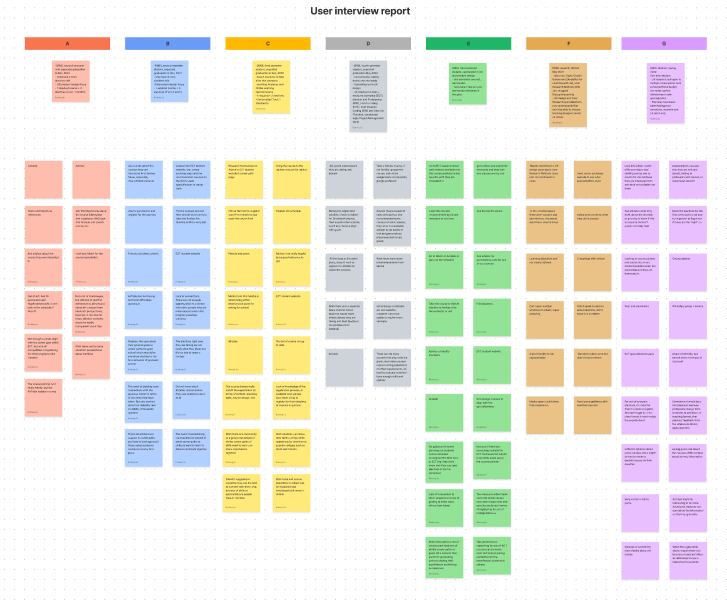
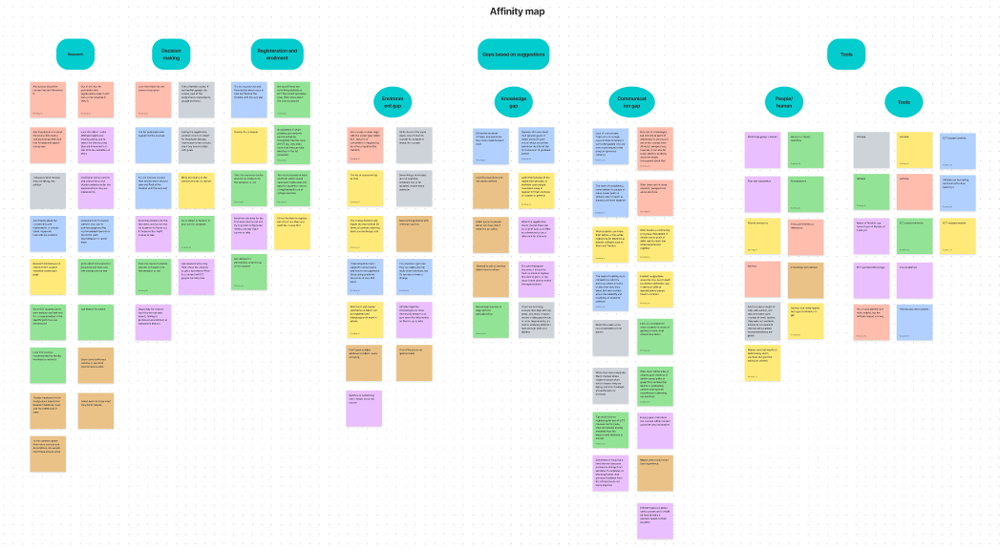
This solution is welcome by and useful for the students. In a recent Community Hour meeting on the subject of Choosing Courses, students received, students expressed gratitude to the designers and developers of the Airtable.
Below is a demonstration of the use of the Airtable:
Electives and Required Course Planner
The course planner has been redesigned to accommodate for Steinhardt’s new LTXD program and its requirements, and to improve its user interface. It is expected that the new and improved planner, along with the new initiatives to promote its use by students and academic advisors, result in a better tool to help students navigate their course journey. The use of the course planner applies to both required and elective courses.
Below is a demonstration of the use of the course planner:
RQ2: How do students learn about the specializations, the curricular and extra-curricular learning opportunities associated with them, and their value in the industry?
The main source of centralized information and resources for ECT students is in the All things ECT! website. The current website is organized by sections covering from important academic information to job resources for alumni.
The website interface seems easy to navigate. All the required elements are present in the website. As of this writing there is no website usage analytics available that can shed light on the most accessed pages. Also, there’s no available data regarding usability testing of the website.
Specializations
The All things ECT! website contains a page named Career Pathways. It seems to be a fairly recent addition to the website (see screenshot below).

The page provides detailed information on different areas of the industry where students can specialize and dedicate their professional lives to. Each of the listed areas of specializations provide general information about the industry and the available career options. As the navigator of the page scrolls, they can find a section entitled “Which Courses Should I Take?” containing a list of elective courses, both inside and outside of the ECT program, that can assist the student in defining the area of specialty within each specialization. Below is the list of courses for the Instructional Design pathway.
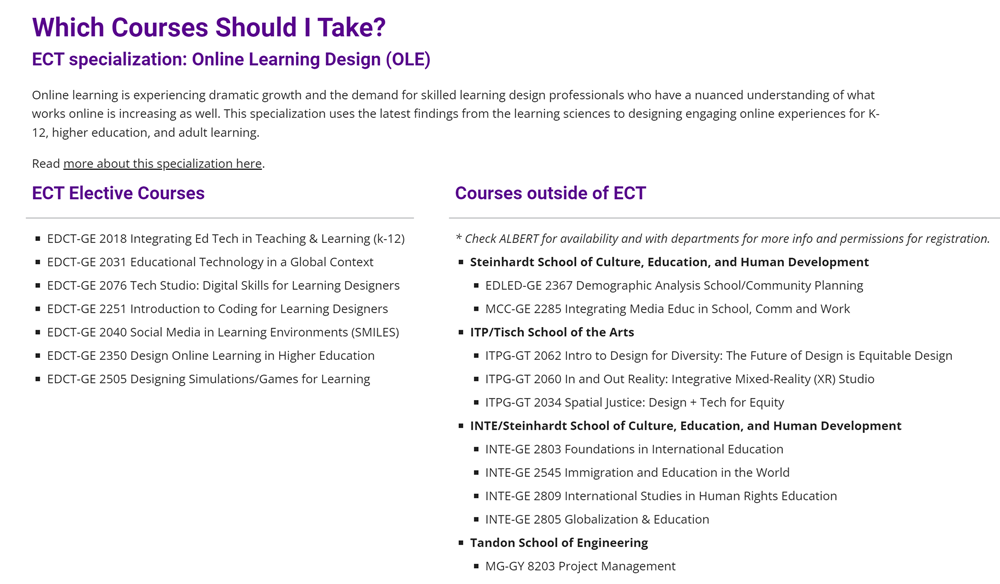
Curricular and Extra-curricular Learning Opportunities
NYU Steinhardt, as well as NYU as institution provide a wealth of additional learning opportunities to students and alumni. Every student receives announcements of many events that relate to many areas, including areas of their interest. For example, NYU LEARN network provides excellent opportunities and events to those students who want to specialize in learning analytics or further pursue a Doctoral degree in Education and Communication Technology.
In a similar manner, there are workshops, forums, and special events with guest speakers that provide students with deeper understanding of the areas of specializations at the same time that provides the means for sharing work and exchanging ideas related to their areas of interest.
The All Things ECT! website, however, doe not centralize all the available events of interest to students. Each event is promoted and communicated separately.
RQ3: At the present, how do students identify their professional goals and which specialization(s) best align with their skills and interests?
Considering that there is no data available at the present on usage or usability of the current means of communication and information access by students, I can only concentrate on providing an overview of the existing resources for students to identify their professional goals.
One of the most effective resources for this purpose is the J Term Course - Professional Applications of Educational Media and Technology. The course covers a wealth of information regarding industry, preparation to enter the workforce, use of portfolio, communication skills, etc., that will prepare students to enter the workforce.
Another resource is direct advising from each student’s Academic Advisor. Academic Advisors serve as a link between students' experience and professional development. Advisement provides the framework for educational planning and assessing progress toward educational, personal, and career goals.
Findings

The changes that the ECT program is currently experiencing provide an excellent opportunity to analyze the access, type and frequency of use, and effectiveness of the current resources for students to make decisions about their areas of interest and define their career path. There are several actions that can be taken to improve the current access to existing resources by students.
Analytics and usability testing can provide information on the current state of the existing resources. Such analytics and testing can also suggest possible gaps in the process of students access and use of career and academic resources, and possible needs to build upon or expand current resources.
There are vast existing sources of information that students can use to plan and access courses and other professional opportunities, events and communities. However, there is no central point of communication or promotion of those sources, making them look like they are competing with each other, rather than contributing to the preparing students to define and pursue their career goals. Furthermore, some of the communication about events and resources might get lost in the large amounts of announcements that students receive.
The recent improvements in the Airtable for elective courses, the new design of the students’ course planner, and the new LTXD program with updated courses and less credit requirements provide more convenient ways for students to obtain, trace and use information about their academic choices. When those new and refined resources are combined with the Career and Specializations pages of the All Things ECT! website, students can obtain plenty of useful information that is vital to make informed academic and career decisions.
The current efforts (such as the ECT Community Events) to reach out to students to make them aware of the existing tools and resources provide good opportunities for personalized receiving of information. However, there is no data that can measure attendance or impact of the events.
The current problem does not lie in the existence or type of resources, but in the way such resources are made available and accessible to students. Also, the current resources are managed and updated as needed. At the present moment, there is no designated person or system to centralize the management, monitoring and control of the existing resources.
Recommendations
Before creating new resources or software tools to address gaps in the students’ awareness or access to current resources, it’s essential to analyze the current and existing resources to determine:
- * If students are fully aware of the existing resources, their use and purpose
- * If the current resources are easily accessible, useful and efficient
- * If the current resources require updates and/or improvements
- * If the current resources are presented in a student-centered manner, meaning, in a way that addresses the needs of the students and answers their questions
- * The frequency in which students will need to use the current resources
- * If a new tool will improve or solve any of the found gaps or problems
Additionally, a learner-centered approach to designing a system of resources for students can help address the most common problems and reasons why students might not have awareness or access to the various existing resources, or gaps in resources or services that can further assist students in their determination of the academic path at ECT.
Obtaining data and analytics on visits, attendance, access and usage of the existing resources can help identify trends and patterns in if/how students engage with the All Things ECT! website and the effectiveness of the existing communication channels for events, forums and other resources.
Usability testing of the current resources can also provide information on the access and usage of the resources, and can pose research questions regarding increase of usage based on improvements in the way the resources are promoted and made available.
Career Pathway Frameworks
Within the arena of higher education, there are many frameworks that have been created and implemented to study and develop effective learning experiences in higher education. An example of one such framework is the one developed by Iatrellis et al. (2019) named Integrated learning Pathways. That framework was introduced based on the premise that the learning experience of the student consists of a series of processes, and therefore, the model aims at developing and implementing well-organized intra-organizational processes and to improve quality and efficiency of students’ paths.
Another area of relevance in designing a streamlined system of resources for students is the study of the most common needs or reasons for students to slack or procrastinate in accessing or using the available resources. There are studies that shed light on both internal and external reasons for academic procrastination (which could explain low attendance to Community Events, for example). Such studies can help as background research for a learner-centered. For example, one study provides the most common internal and external reasons students tend to procrastinate in the actions they need to take to manage their studies (Grunschel et al., 2013), which can help align and map existing students’ needs with decisions and/or actions taken to design and improve the current pool of resources. Grunschel et al. summarize and categorize the internal an external reasons. Their research table summary of reasons is attached in the document below.
The AAAM Framework
The existing models, however, mostly focus on sophisticated use of technologies, such as AI and machine learning, in a modular fashion, with the purpose of shaping institutional processes, from application to graduation, and at the institution level. For the purposes of this study, a simpler approach can be more useful as a starting point. For that purpose, I created the AAAM framework for streamlining existing resources. This framework intended to serve as a support or guide for building upon and expanding of the structure of the current stream of resources into a system designed to be student-centered, centralized, consistent and timely.
AAAM stands for:
- Awareness: addresses the need of students knowledge of the existence of the resources
- Access: provides the means for obtaining, examining, enrolling in, or retrieving the resources
- Action: provides the necessary information for students to make decisions using the resources
- Monitoring: provides consistent and timely monitoring of updates, changes and required efforts to keep the resources relevant to students
The three A's of the framework are inspired by Glushko’s (2013) The discipline of organizing, where resources are defined and prepared based on an assessment of what is being organized, why, how much, when and by what means. The monitoring part of the framework comes from a combination of common project management techniques, used to manage and control the use and flow of resources, and Lean Six Sigma management approaches to improve performance by removing wasteful actions or resources and reducing variation. The framework helps in analyzing the usefulness of resources and the way they are managed to ensure they purposely, rightfully and effectively exist.
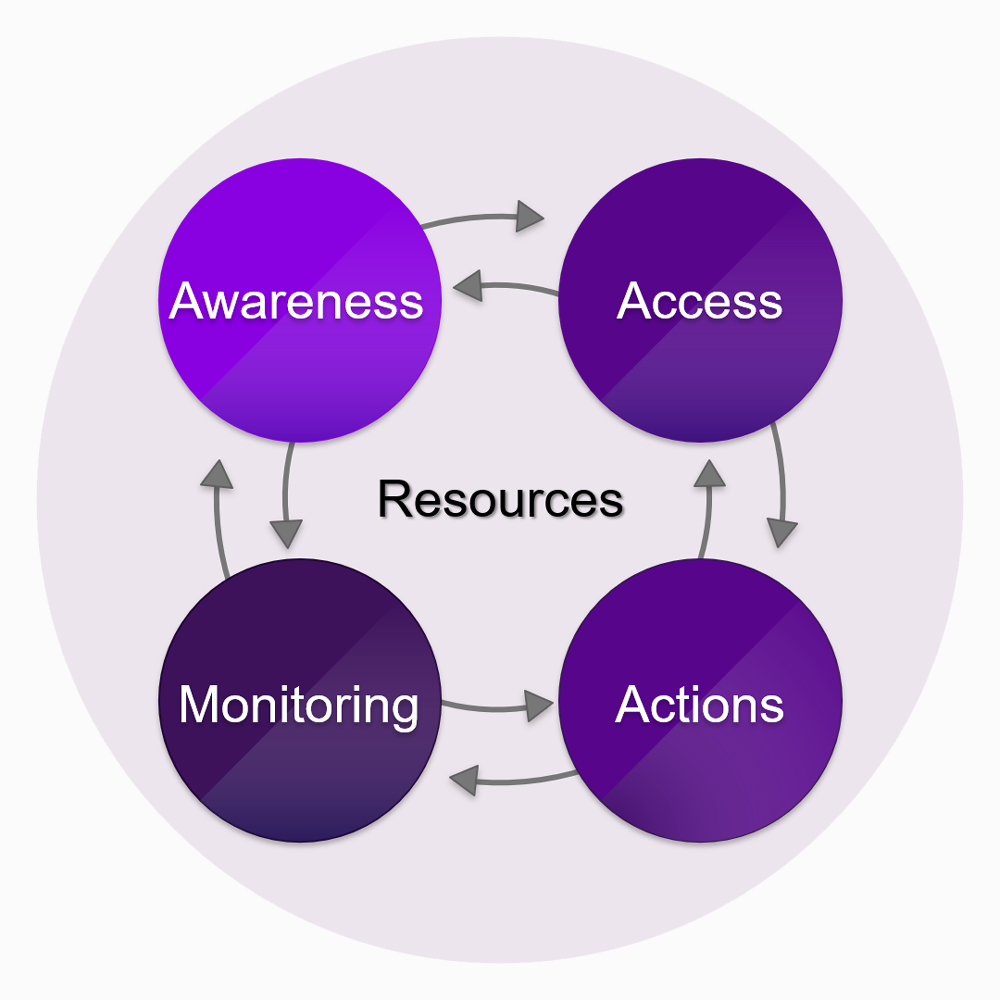
The purpose of the AAAM framework is to organize the design of resource allocation and access for students in a manner that address their most common needs. The specific characteristics, usefulness and importance of each resource, as well as its location and logistics behind the dissemination of the messages about its existence, can be determined based on one or more of the factors of AAAM.
Application of the AAAM Framework: Outcomes
Below is a discussion of how the AAAM framework can help obtain the best outcome that aligns with the goals as stated above. As example, I am using the proposed solution by Ye, Yang and Yang, with the design ideation named Bobcat: NYU Course Selection, and its original design research, NYU Course Selection, by Yang, Yang, Hong and O’Hara (reports embedded below).
I will apply the AAAM framework to analyze their research and design, reconciling the proposed design solution with the established goals and outcomes.
Addressing Problems and Innovative Solutions
The AAAM framework can help address the meaningful problems faced by students, as stated in the study conducted by Hong, Yang, Yang and O'Hara, where students (particularly, first semester students) expressed concerns about the use of the course planner for future courses, understanding the different course offerings and types, and using Albert to search and find suitable required and elective courses, among others.
The framework also provides an opportunity for innovation by implementing better management of current and existing resources for students, applying better and more effective uses of current resources, and opening the path for improvements and new tools as/if needed.
The Design Process
Yang et al. prototyped an app that can address the most common expressed concerns from students as per their surveys and data collection. The student-centered app aims at centralizing the needed course information, as well as improving or filling the gaps in communication that sometimes occur between the students and their Academic Advisors.
Using the AAAM framework to evaluate the use of an app to address can shed light on whether the app makes improvements to the process, considering the following:
- * A new app will require resources dedicated to its creation and maintenance; it will be necessary to study if dedicating such resources for the app provides an adequate ROI.
- * The new app will not replace the existing communication streams or existing tools (such as Albert, Slack, and email communication). That means that the app will be an addition to existing (and rather scattered) resources and tools, some of them competing with each other.
- * The existence of the app may not solve the problem of awareness; it will in fact, be yet another tool that will have to be promoted and advertised in addition to events, the course planner and announcements, using the different existing communication venues.
- * Since it is expected that the app will not replace Albert, students will still have to search and find the desired courses in Albert after obtaining the desired information in the app. That poses the question about redundancy in the process of searching and finding, keeping in mind that we also have the Airtable for elective courses (although it was created after this study).
- * Some features of the app might fill existing gaps, while other features might be redundant. For example, the feature of the app that helps communication with Academic Advisors might be quite useful, but finding elective courses might be redundant because of the existing Airtable.
- * Access to the app does not mean access to registration for the listed courses. However, it could be a better way of reaching out to from Academic Advisors.
The Context and the Learners
The interviews conducted by both the Yang et al. and Ye et al. use personas to characterize the experiences of students when searching, selecting and enrolling in courses. Below is an example of one of the personas used in the design by Yang et al.
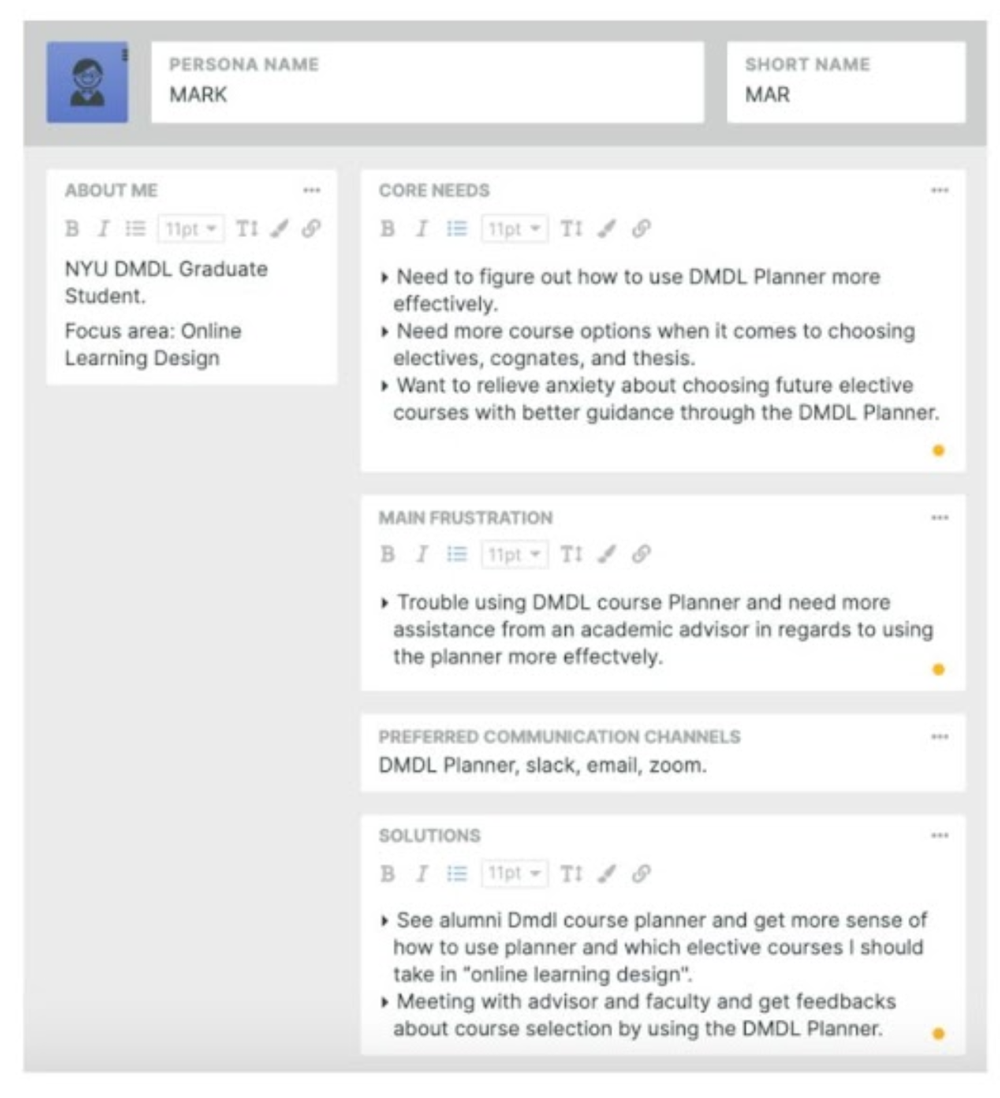
The analysis and design using the personas provides the means for studying their application under the lens of the AAAM framework. For example, in the persona shown above, the student become aware of the possible available course options through the Course Planner, Slack and email. Same information can be obtained from the personas regarding access, actions and yearly updates.
Designing an Effective Solution
The AAAM framework can help in the determination of the effectiveness of the proposed solutions. For example, the design ideation proposed by Ye et al provides a scenario where the proposed app opens the communication between the student and the Academic Advisor. Below is the representation of that part of the design ideation.
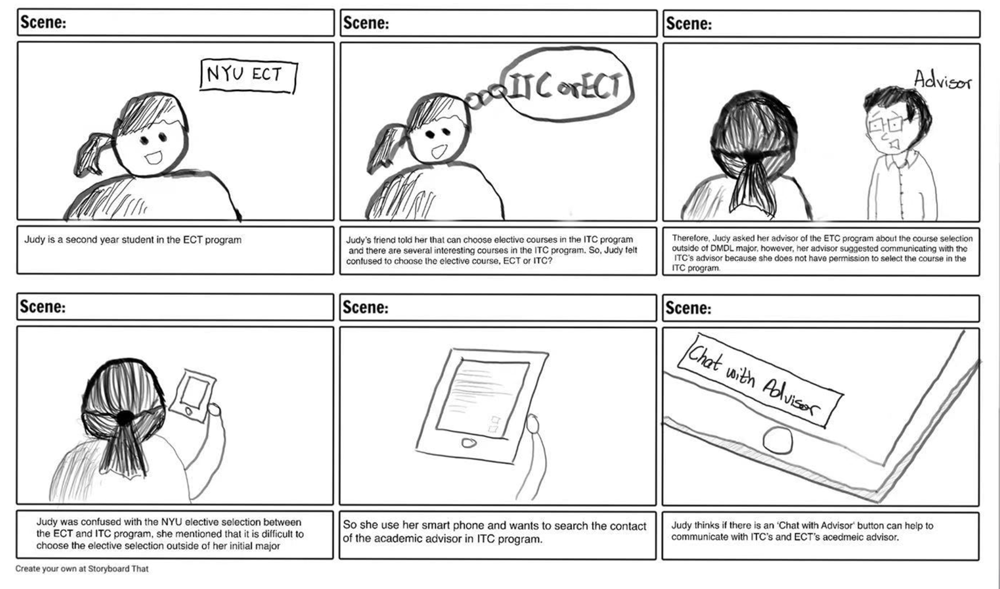
Using the AAAM framework can help answer the following questions:
- * How did the student become aware of (a) the course they are interested in, and (b) ways of communicating to the Advisor in a timely manner?
- * Does the design provide the means for easier and better access to accomplish the task?
- * How easy is for the student to accomplish her goal (in this case, make a decision with the help of the Academic Advisor)?
- * How current and updated the information, and the means to access it, are?
Evaluation
The AAAM framework can help as an agile evaluation model. It does not substitute other evaluation models, especially when sophisticated analyses are required, but the framework can help as a way of ensuring the meaningfulness of the design as it is developed and prototyped. It can be used as a pre-evaluation tool for a complex project to verify that the path taken aligns with the goals and objectives of the design.
Below is a screenshot of the Figma prototype created by Ye et al.
The AAAM framework can be used to analyze the awareness, access, actions and time spent using the app or website before using Kirkpatrick’s or Brinkerhoff’s to evaluate successful use and process or usability improvements.
Adaptability
The framework can be used to ask guiding questions regarding future updates and if and how the app can be adapted to future changes, that is, changes in technologies, means of communication, or changes in content to reflect the ways the program evolves.
For example, the BOBCAT prototype adds “4 areas” to the system and creates a general catalog for students to use. Based on course level, it provide elective courses information and students’ favorite courses. Questions to ask about adaptability using the AAAM framework are:
- * How do students become aware if/when there are different or new areas due to program changes?
- * How does the app provide the means for questions regarding changes, or additional information on the current areas, or availability within the current areas?
- * Does the system provides means of tracking all the actions that the student must take for each term?
- * How does the system communicate updates or alerts regarding deadlines?
Conclusion

Related to presence and existence of information, the NYU Steinhardt website, the All things ECT! website, students' academic advisors, the current course planner provided to students, the Airtable customized content of elective courses, and the ECT Community events are resources that provide a wealth of information regarding the current ECT program from basic information of the program, to detailed information on different areas of specializations. The information in all those resources is properly maintained; it is current and revised regularly. The way the information is maintained current is by manually entering information in the web pages or Airtable, and by organizing events that are used to create live spaces for students to ask questions. Additionally, the J Term Course, Professional Applications of Educational Media and Technology, provides excellent content for students to delineate and shape their careers to tailor their interests. However, the J Term course is offered only once a year and J Term only, not during any other season of the academic year. Albert is used for the purposes of managing the logistics and processes of the student's life at NYU, and as such, it is not available for manual updates. In similar manner, the information provided by Albert is not meant to be used for students to make academic path decisions, but to manage processes that support their choices of courses and areas of specializations. In fact, the efforts, studies and designs made by other studies to create systems that provide access to necessary information are the result of the lack of flexibility that the Albert system provides.
The current designs and solutions provide necessary information, and when tested, they have been well received by students. The ECT Community event that demonstrated the access and use of the Airtable for electives, for example, caught interest from the students who were present at the event. In similar manner, the test of the BOBCAT app for course selection was well received by the testers of the app. However, there are questions in terms of the level of reach that the existing available tools and communication venues have, so there are questions regarding usage and access of those resources. In similar manner, there was no available usage or access data for the websites and social media used by ECT to disseminate information.
It is necessary, therefore, to take a closer look at analytics and use the information that they provide to decide if the creation of new or more resources is needed, or otherwise if streamlining or promoting existing venues constitutes a better and more practical solution. Usability testing of the existing means of communication can also shed light on whether the students have to navigate through different venues to obtain information, if the information obtained by multiple channels of communication is consistent, and if the use of multiple channels provides convenience to students.
“There are neither enough carrots nor enough sticks to improve undergraduate education without the commitment and action of students and faculty members. They are the precious resources on whom the improvement of undergraduate education depends.” - Arthur W. Chickering
References
- Chickering, A. W., and Gamson, Z. F. (1987). Seven Principles For Good Practice in Undergraduate Education. American Association for Higher Education - Bulletin.
- Gilbert, C. G., Crow, M. M., and Anderson, D. (2017). Design Thinking for Higher Education. Stanford Social Innovation Review, 16(1), 36–41. https://doi.org/10.48558/00MV-7982
- Glushko, R. J. (2013). The discipline of organizing. Bulletin of the American Society for Information Science and Technology, 40(1), 21–27. https://doi.org/10.1002/bult.2013.1720400108
- Grunschel, C., Patrzek, J., and Fries, S. (2012). Exploring reasons and consequences of academic procrastination: An interview study. European Journal of Psychology of Education, 28(3), 841–861. https://doi.org/10.1007/s10212-012-0143-4
- Iatrellis, O., Savvas, I. K., Kameas, A., and Fitsilis, P. (2020). Integrated Learning Pathways in higher education: A Framework enhanced with machine learning and semantics. Education and Information Technologies, 25(4), 3109–3129. https://doi.org/10.1007/s10639-020-10105-7


